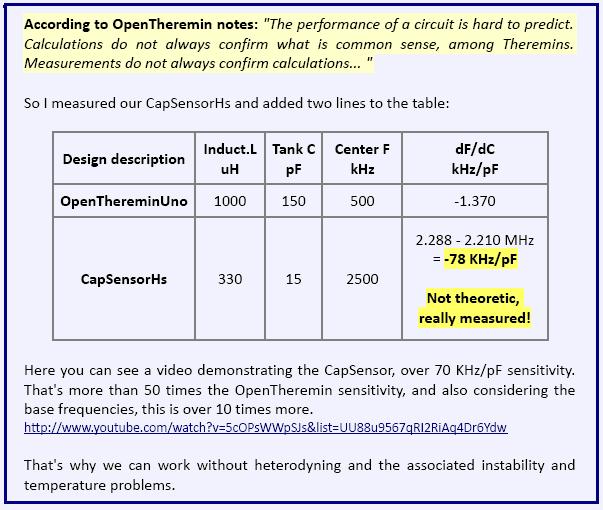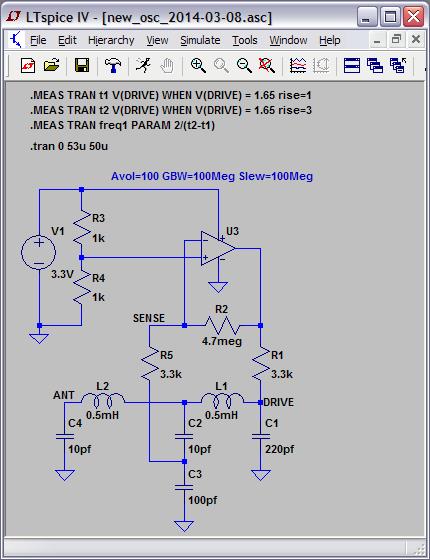"More the oscillator sensitivity is low and more it must be "amplified" in some way. Heterodyning is a good method to amplify little frequency changes of the oscillator but, doing this, you amplify also the oscillator instabilities and the temperature induced frequency changes." - livio
Oh hell - you might be right.. But I dont think you are, and my expierience says your not.
I dont see heterodyning as "amplification" I see it as removal of redundant data - a way of eliminating the "dead time" and therebye allowing increase in the resolvable data more quickly - as in, you can resolve the data from direct-oscillator period to the same resolution as you can from heterodyning, but doing so will take much longer - an the order of 10 times longer or more probably.
As I see it, division of a HF oscillator is equivalent to integrating any individual HF cycle errors, in the same way as the integration like function of a fixed antenna capacitance - there is a reduction in sensitivity, as in, the changing antenna capacitance is || to a fixed capacitance - but this IMO actually could under certain circumstances improve SNR.
But I probably dont know what I am talking about, so im going to leave this thread - at least until it returns to being a "Let's Design and Build a (mostly) Digital Theremin!" thread rather than being the "Theremino" thread.
I think the only thing I have said on this matter which is really valid is this:
"As you are both "open" projects, why not collaborate? Get the best of both of your designs and software - I really think that with your software, open.theremins heterodyning topology, and perhaps an oscillator improvement / redesign, some really good digital modular theremin stuff could get to market."
But I think any advice to you that includes heterodyning will fall on deaf ears, deafer than an EW with its antenna inductor removed!
;-)
Fred
ps - I really do think you should start your own Theremino thread - this thread IMO needs to get back on track. Dewster has hinted that he wants this, but is too polite to keep pestering you - I, on the other hand, am an impolite uncouth arrogant unpleasant arsehole who says what he thinks - And I no longer give a damn about what people think of me.
THE FOLLOWING WAS ADDED AFTER THE REPLY BELOW, After I had fully checked out the links given - --
"Here you can see a PDF with the sensivity of the most known oscillator configurations:
www.theremino.com/files/Theremins_Sensitivity.pdf"
This is a butchered version of Fred Nachbaur article, and the conclusions you have drawn are simply wrong and do not relate in any way to the Theremino design (Fred Nachbaur's paper only relates to heterodyning - the frequency variation as a function of capacitance is meaningless when you are using the HF oscillator period variation to derive data ).
I also really dislike the way you put down the open.theremin in this paper -

THE ABOVE IS JUST COMPLETELY IRRELEVANT and INNACURATE NONSENSE IMO! - and heterodyning does NOT have "instability and temperature problems" !!!! the ideas of "sensitivity" are completely irrelevant - the relevant matters are RESOLUTION and LATENCY and the open.theremin topology is not being compared on these grounds, but on latency is better than the theremino and also probably beats the theremino on resolution, or certainly has the potential to (Because it uses heterodyning!)!
Comparison of your theremino vs the open.theremin using Fred Nachbaur's kHz/pF is like multiplying apples with tomatoes - and in fact, gives FALSE -Ve representation of the open.theremins performance against the BOGUS and meaningless "results" given for theremino.
In my view, given that your facts are WRONG, and that MANY of the specifications, particularly with regard to resolution are WRONG, your agenda becomes clear.. Despite being "Open" you identify open.theremin as a competitor to be put down.. Suggestion of a collaboration with open.theremin is therefore the last thing you wanted and something you dont want to even comment on.
I also want to make it clear that I am not involved with open.theremin in any way, do not own one, and have been critical of some aspects of its design in the past - But I can see some well implemented aspects to it, and get angry when I see any product, particularly an open project, being bashed with false data and false comparisons by a competitor.
"And here a test of the CapSensor sensitivity:
CapSensor oscillator sensitivity - YouTube Video"
Theremino Theremin, eight octaves range with steady notes - YouTube video
A large area antenna for CapSensor tests - YouTube video
These videos shows nothing that proves anything with regard to the specifications being discussed here (resolution vs latence etc)
The following video IMO however, demonstrates your great strength - the software! - I have not seen any theremin software that comes close to what you are producing:
Theremino Theremin, chords played at great distance - YouTube video


